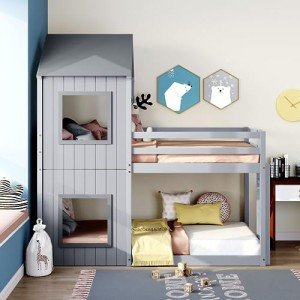A Comprehensive Guide to Children's Bunk Beds: Styles, Benefits, and Safety Considerations
Bunk beds have ended up being a popular option for families looking to optimize space and supply an enjoyable sleeping environment for children. With their special style, they provide an innovative and practical option for shared bed rooms, playrooms, or even guest lodging. This short article explores the various styles of kids's bunk beds, their benefits, safety considerations, and responds to some regularly asked concerns.
The Allure of Bunk Beds
Children's bunk beds are more than simply space-saving structures; they are also a gateway to daring dreams and creative play. Below is a detailed assessment of their many advantages.
Advantages of Bunk Beds
- Space-Saving: Bunk beds efficiently use vertical space, making them an ideal option for smaller spaces.
- Playful Design: Many bunk bed styles consist of slides, camping tents, and themed elements, triggering imagination and excitement.
- Partner Sharing: Bunk beds are best for brother or sisters sharing a space or accommodating pajama parties.
- Flexible Use: Some designs can be separated into two private beds, using versatility as kids grow.
- Storage Options: Many bunk beds include built-in drawer storage or shelves, even more boosting their functionality.
Styles of Children's Bunk Beds
The variety of bunk beds available today caters to various choices and needs. Below is an introduction of some popular designs.
| Style | Description | Best For |
|---|---|---|
| Standard Bunk Bed | A conventional style including one bed stacked above another. | Siblings sharing a room. |
| Loft Bed | Comparable to a bunk bed without the bottom bunk, enables a work area or play location below. | Restricted space for play/desk. |
| L-Shaped Bunk Bed | 2 beds arranged in an L-shape, frequently with additional areas for storage or play. | Distinct room designs. |
| Twin Over Full | A twin bed over a full bed, accommodating various sleep requirements. | Growing children and teens. |
| High Sleeper | Stands even higher than a loft bed, generally including a desk or play location below. | Older kids needing more play/desk space. |
| Tent Bunk Bed | Bunk beds with a canopy or tent-like structure, creating a cozy, fun space. | Active and imaginative children. |
Secret Features to Consider
When picking the right bunk bed for kids, the following features deserve considering:
- Material: Bunk beds can be made from wood, metal, or a combination. Each has its distinct visual and resilience.
- Weight Capacity: Always confirm the weight limit of the bunk bed to guarantee it can accommodate your children safely.
- Safety Rails: Ensure the leading bunk has tough rails to avoid falls.
- Ladder Security: A properly designed ladder should offer easy and safe access to the upper bunk.
- Completing: Ensure any surfaces are non-toxic and safe for children.
Safety Considerations
Security is paramount when it concerns children's bunk beds. The following standards should be adhered to:
- Age Appropriateness: Generally, kids under six years of ages ought to not oversleep the upper bunk due to safety threats.
- Tough Construction: Ensure the frame and products are strong and can support the weight without sagging.
- Regular Maintenance: Periodically examine for loose screws, bolts, or other elements that might require tightening.
- Clear Play Area: Keep the area around the bunk bed devoid of toys and barriers to decrease tripping threats.
Setting Rules for Safe Use
Developing standards for bunk bed use will assist guarantee safety:
- Limit Jumping and Climbing: Children ought to be encouraged versus leaping from the leading bunk and getting on the sides.
- Supervising Sleepovers: Monitor young guests while they are utilizing the bunk bed for the very first time.
- Educate on Ladder Use: Teach how to utilize the ladder safely, highlighting the value of dealing with the ladder when climbing up or down.
Often Asked Questions
1. What age is appropriate for a child to sleep in the leading bunk?
The majority of manufacturers recommend that kids must be at least 6 years of ages to sleep in the upper bunk. Hortense Spaid is created to mitigate the risk of falls.
2. Can bunk beds be personalized?
Yes, numerous producers use adjustable options, consisting of colors, products, and additional features like drawers or desks.
3. Are bunk beds safe for weight?
Bunk beds have weight limitations, usually ranging from 200 to 400 pounds, depending upon the model and product. Always inspect the maker's specs.
4. How do I preserve and clean a bunk bed?
Routinely examine for loose parts, keep the bed clean by wiping down surfaces, and guarantee the bed linen is fresh to promote a safe and sanitary sleep environment.
5. Can bunk beds be separated into private beds?
Numerous bunk beds come with an option to separate them into 2 private beds, providing long-lasting flexibility.
Kid's bunk beds are more than mere furnishings; they are a practical, versatile, and creative part of a kid's room. With different styles available and many security considerations to remember, parents can choose the best bed that fits their space, fulfills their kids's needs, and imparts a sense of adventure. By comprehending the benefits, styles, and precaution associated with bunk beds, households can create a delightful and safe sleeping environment for their kids. Whether for siblings sharing a room or space-saving options, bunk beds remain a precious choice for lots of families.

